Mehran Soltani
Experimental validation of machine-learning based spectral-spatial power evolution shaping using Raman amplifiers
Sep 26, 2022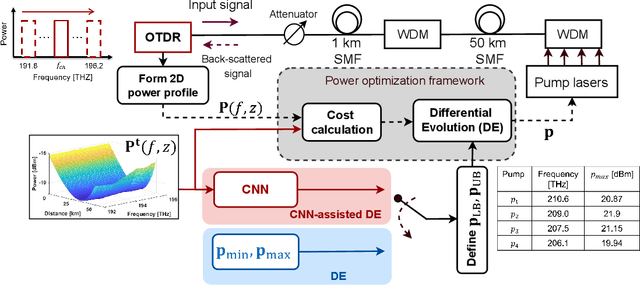

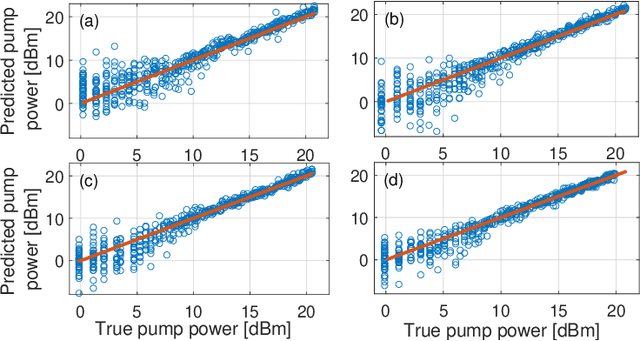

Abstract:We experimentally validate a real-time machine learning framework, capable of controlling the pump power values of Raman amplifiers to shape the signal power evolution in two-dimensions (2D): frequency and fiber distance. In our setup, power values of four first-order counter-propagating pumps are optimized to achieve the desired 2D power profile. The pump power optimization framework includes a convolutional neural network (CNN) followed by differential evolution (DE) technique, applied online to the amplifier setup to automatically achieve the target 2D power profiles. The results on achievable 2D profiles show that the framework is able to guarantee very low maximum absolute error (MAE) (<0.5 dB) between the obtained and the target 2D profiles. Moreover, the framework is tested in a multi-objective design scenario where the goal is to achieve the 2D profiles with flat gain levels at the end of the span, jointly with minimum spectral excursion over the entire fiber length. In this case, the experimental results assert that for 2D profiles with the target flat gain levels, the DE obtains less than 1 dB maximum gain deviation, when the setup is not physically limited in the pump power values. The simulation results also prove that with enough pump power available, better gain deviation (less than 0.6 dB) for higher target gain levels is achievable.
Spectral and spatial power evolution design with machine learning-enabled Raman amplification
Nov 25, 2021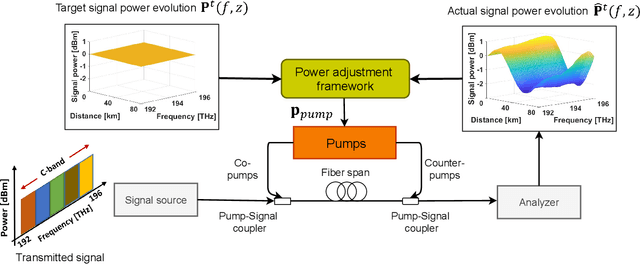

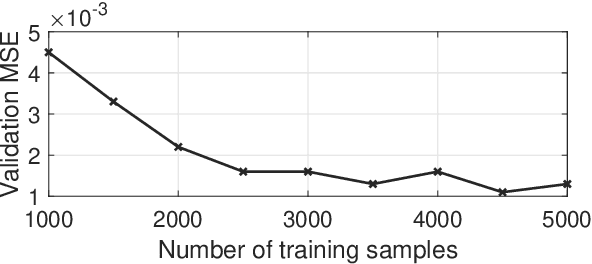
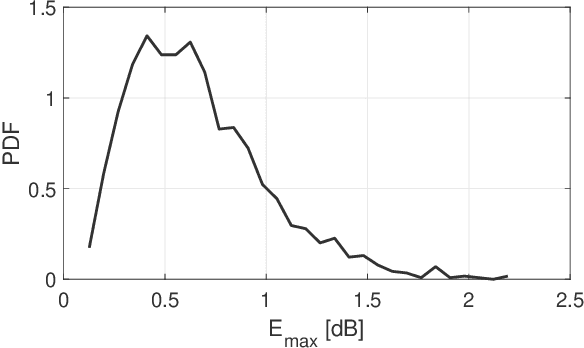
Abstract:We present a machine learning (ML) framework for designing desired signal power profiles over the spectral and spatial domains in the fiber span. The proposed framework adjusts the Raman pump power values to obtain the desired two-dimensional (2D) profiles using a convolutional neural network (CNN) followed by the differential evolution (DE) technique. The CNN learns the mapping between the 2D profiles and their corresponding pump power values using a data-set generated by exciting the amplification setup. Nonetheless, its performance is not accurate for designing 2D profiles of practical interest, such as a 2D flat or a 2D symmetric (with respect to the middle point in distance). To adjust the pump power values more accurately, the DE fine-tunes the power values initialized by the CNN to design the proposed 2D profile with a lower cost value. In the fine-tuning process, the DE employs the direct amplification model which consists of 8 bidirectional propagating pumps, including 2 second-order and 6 first order, in an 80 km fiber span. We evaluate the framework to design broadband 2D flat and symmetric power profiles, as two goals for wavelength division multiplexing (WDM) system performing over the whole C-band. Results indicate the framework's ability to achieve maximum power excursion of 2.81 dB for a 2D flat, and maximum asymmetry of 14% for a 2D symmetric profile.
Inverse design of Raman amplifier in frequency and distance domain using Convolutional Neural Networks
Feb 21, 2021
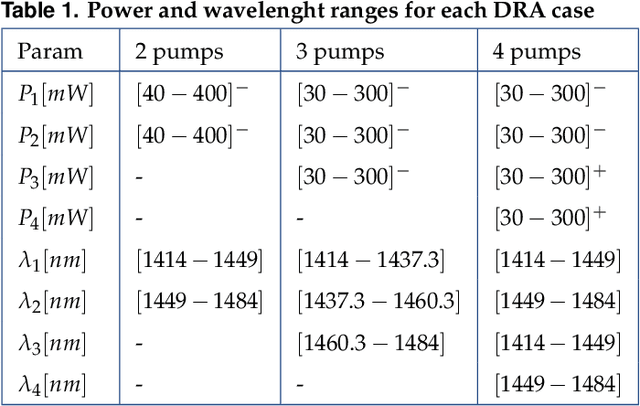
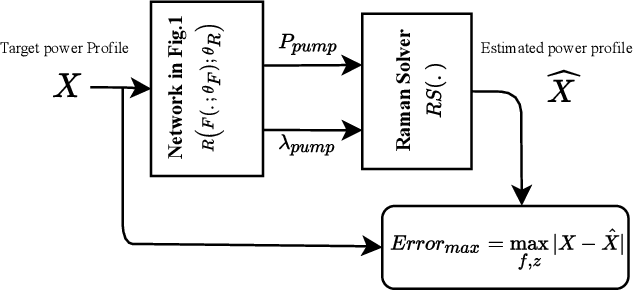
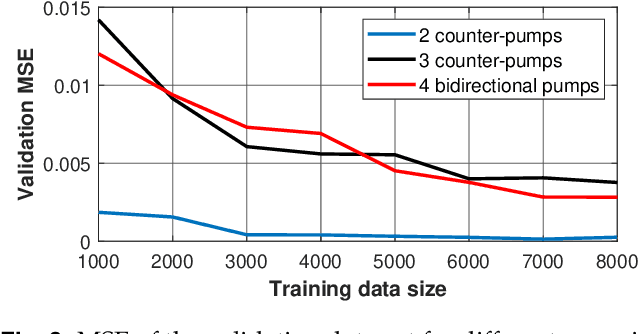
Abstract:We present a Convolutional Neural Network (CNN) architecture for inverse Raman amplifier design. This model aims at finding the pump powers and wavelengths required for a target signal power evolution, both in distance along the fiber and in frequency. Using the proposed framework, the prediction of the pump configuration required to achieve a target power profile is demonstrated numerically with high accuracy in C-band considering both counter-propagating and bidirectional pumping schemes. For a distributed Raman amplifier based on a 100 km single-mode fiber, a low mean set (0.51, 0.54 and 0.64 dB) and standard deviation set (0.62, 0.43 and 0.38 dB) of the maximum test error are obtained numerically employing 2 and 3 counter, and 4 bidirectional propagating pumps, respectively.
Deep Feature Selection using a Teacher-Student Network
Mar 17, 2019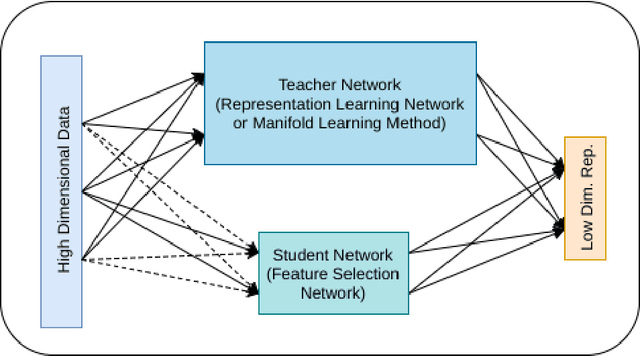

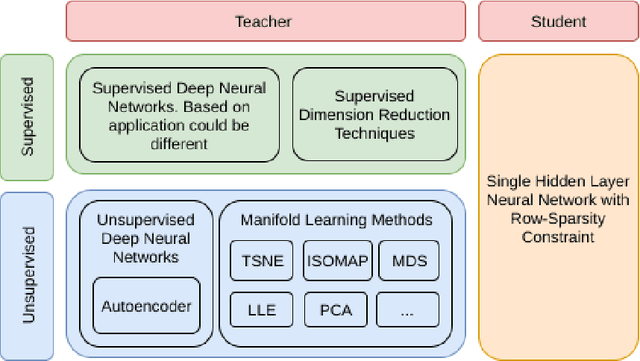

Abstract:High-dimensional data in many machine learning applications leads to computational and analytical complexities. Feature selection provides an effective way for solving these problems by removing irrelevant and redundant features, thus reducing model complexity and improving accuracy and generalization capability of the model. In this paper, we present a novel teacher-student feature selection (TSFS) method in which a 'teacher' (a deep neural network or a complicated dimension reduction method) is first employed to learn the best representation of data in low dimension. Then a 'student' network (a simple neural network) is used to perform feature selection by minimizing the reconstruction error of low dimensional representation. Although the teacher-student scheme is not new, to the best of our knowledge, it is the first time that this scheme is employed for feature selection. The proposed TSFS can be used for both supervised and unsupervised feature selection. This method is evaluated on different datasets and is compared with state-of-the-art existing feature selection methods. The results show that TSFS performs better in terms of classification and clustering accuracies and reconstruction error. Moreover, experimental evaluations demonstrate a low degree of sensitivity to parameter selection in the proposed method.
 Add to Chrome
Add to Chrome Add to Firefox
Add to Firefox Add to Edge
Add to Edge